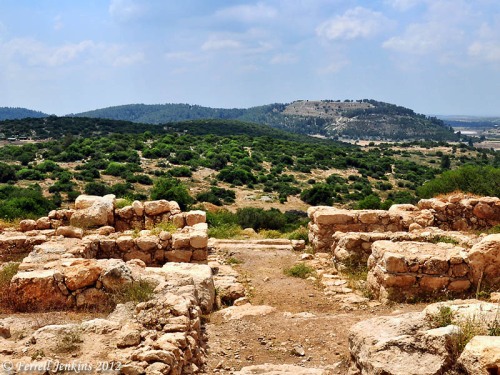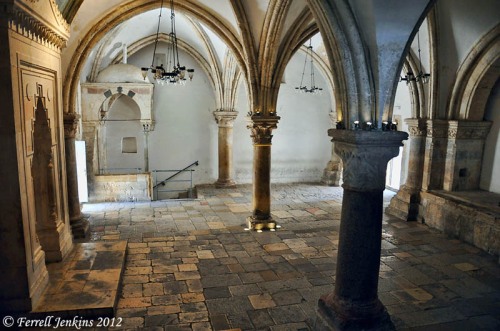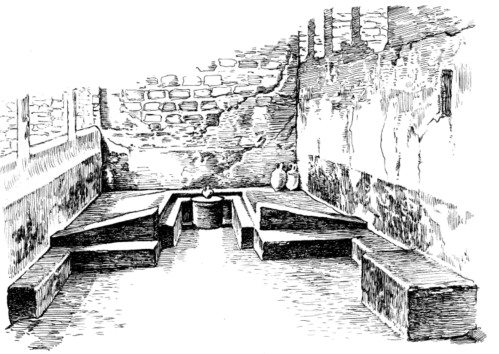Posted By
MSH on April 9, 2012
Over the weekend I had occasion to send a friend some pages from my
Myth That is Truefirst draft that pertained to a difficult passage,
1 Peter 3:14-22. I could hardly believe I had not posted on it before (searched for it and came up empty). So, I’ve decided to include it at some point in the podcast series on baptism. I’ve actually been present in a church where the pastor, working through 1 Peter, actually announced he was skipping the passage because it was too strange. True, it’s weird, but it’s actually quite comprehensible against the backdrop of what I call the divine council worldview. So, here it is.
14 But even if you should suffer for righteousness’ sake, you will be blessed. Have no fear of them, nor be troubled, 15 but in your hearts regard Christ the Lord as holy, always being prepared to make a defense to anyone who asks you for a reason for the hope that is in you; 16 yet do it with gentleness and respect, having a good conscience, so that, when you are slandered, those who revile your good behavior in Christ may be put to shame. 17 For it is better to suffer for doing good, if that should be God’s will, than for doing evil. 18 For Christ also suffered once for sins, the righteous for the unrighteous, that he might bring us to God, being put to death in the flesh but made alive in the spirit, 19 in which he went and proclaimed to the spirits in prison, 20 because they formerly did not obey, when God’s patience waited in the days of Noah, while the ark was being prepared, in which a few, that is, eight persons, were brought safely through water. 21 And now the antitype—that is, baptism—saves you, not be means of a removal of dirt from the body, but as an appeal to God for a good conscience on the basis of the resurrection of Jesus Christ, 22 who has gone into heaven and is at the right hand of God, with angels, authorities, and powers having been subjected to him.
The overall theme of 1 Peter is that Christians must withstand persecution and persevere in their faith. That much is clear in this passage. But what’s with baptism, the ark, Noah, and spirits in prison? And does this text say that baptism saves us?
Typology as an Interpretive Key
To understand what’s going on in Peter’s head here we have to understand a concept that scholars have called “types” or “typology.” Typology is a kind of prophecy. We’re all familiar with predictive verbal prophecy—when a prophet announces that something is going to come to pass in the future. Sometimes that comes “out of the blue,” with God impressing thoughts on the prophet’s mind that he utters. On other occasions, a prophet might take an object or perform some act and tell people that the thing or action prefigures something that will happen. Ezekiel was notorious for this, like the time God told him to shave his head and beard, weigh it the balances, and then burn a third of it, beat a third of it with a sword, and scatter the last third to the wind to visually portray the future of the city of Jerusalem (
Ezek. 5:1-12). But we only know what Ezekiel’s antics meant because they are spelled out in his prophecies. Ezekiel 5 tells us these are prophecies and what the fulfillment would be. Types work differently.
A type is basically an unspoken prophecy. It is an event, person, or institution that foreshadows something that will come, but which isn’t revealed until after the fact. For example, in
Romans 5:14 Paul tells us that Adam was a tupos of Christ. This Greek word means “kind” or “mark” or “type”—it’s actually where “typology” comes from. Paul was saying that, in some way, Adam foreshadowed or echoed something about Jesus. In Adam’s case, that something was how his act (sin) had an effect on all humanity. Like Adam, Jesus did something that would have an impact on all humanity—his death and resurrection. Another example would be Passover, since it prefigured the crucifixion of Jesus, who was called “the lamb of God.” The point is that there was some analogous connection between the type (Adam) and its echo (Jesus), called the “anti-type” by scholars.
So how does this relate to our weird passage in 1 Peter? Peter uses typology in
1 Peter 3:14–22. Specifically, he assumes that the great flood in Genesis 6-8, especially the sons of God event in
Genesis 6:1-4, typify or foreshadow the gospel and the resurrection. For Peter, these events were commemorated during baptism. That needs some unpacking.
Genesis 6 Backdrop
There are tight connections between
Genesis 6:1-4 and the epistle of 2 Peter and Jude, whose content mirrors 2 Peter is many ways. Peter and Jude Peter were very familiar with Jewish tradition about Genesis 6 in books like 1 Enoch, and believed them. 1 Enoch 6-15 describes how the sons of God (also called “Watchers”) who committed the offense of
Genesis 6:1-4 were imprisoned under the earth (the Underworld) for what they had done. The Watchers appealed their sentence and asked Enoch, the biblical prophet who never died (
Gen 5:21-24), to intercede for them. 1
Enoch 6:4 puts it this way:
“They [Watchers] asked that I write a memorandum of petition for them, that they might have forgiveness, and that I recite the memorandum of petition for them in the presence of the Lord of heaven.”
God sent back his response by way of Enoch, who went to the imprisoned spirits and announced to them that their appeal had been denied (1
Enoch 13:1-3;
14:4-5):
1 “And, Enoch, go and say to Asael, ‘You will have no peace.
A great sentence has gone forth against you, to bind you.
2 You will have no relief or petition, because of the unrighteous deeds that you revealed, and because of all the godless deeds and the unrighteousness and the sin that you revealed to men.’ ”
3 Then I went and spoke to all of them together. And they were all afraid,
and trembling and fear seized them.
1 Enoch goes on to describe the prison term as until the end of days—language that refers to the end times.
2 Peter 2:4 (cp.
Jude 6) makes specific reference to the episode of
Genesis 6:1-4 and the imprisonment of fallen angels in the Underworld. The incident was also on Peter’s mind when he wrote his first epistle—and our strange passage.
Peter saw a theological analogybetween the events of Genesis 6 and their fallout with the gospel and the resurrection. In other words, he considered these events to be types or precursors to New Testament events and ideas.
Just as Jesus was the second Adam for Paul, Jesus is the second Enoch for Peter. Enoch descended to the imprisoned fallen angels to announce their doom.
1 Pet 3:14–22 has Jesus descending to these same “the spirits in prison,” the fallen angels, to tell them they were still defeated, despite his crucifixion. God’s plan of salvation and kingdom rule was still intact. In fact, it was right on schedule. The crucifixion actually meant victory over every demonic force opposed to God. This victory declaration is why
1 Pet 3:14–22ends with Jesus risen from the dead and set at the right hand of God—above all angels, authorities and powers.
Choosing Sides
So how does this relate to baptism? It explains the logic of the passage. Here’s the relevant part once more:
18 For Christ also suffered once for sins, the righteous for the unrighteous, that he might bring us to God, being put to death in the flesh but made alive in the spirit, 19 in which he went and proclaimed to the spirits in prison, 20 because they formerly did not obey, when God’s patience waited in the days of Noah, while the ark was being prepared, in which a few, that is, eight persons, were brought safely through water. 21 And now the antitype—that is, baptism—saves you, not be means of a removal of dirt from the body, but as an appeal to God for a good conscience on the basis of the resurrection of Jesus Christ, 22 who has gone into heaven and is at the right hand of God, with angels, authorities, and powers having been subjected to him.
The two underlined words in verse 21 need reconsideration in light of the divine council worldview. The word most often translated “appeal” (eperotema) in verse 21 is best understood as “pledge” here, a meaning that it has in other material. Likewise the word “conscience” (suneidesis) does not refer to the inner voice of right and wrong here as it does elsewhere. Rather, the word refers to “an attitude or decision that reflects one’s loyalty,” or “conscientiousness,” a usage that is also found in other contexts.
Baptism is not what produces salvation. It “saves” us in that it first involves or reflects a heart decision: a pledge of loyalty to the risen Savior. In effect, baptism in New Testament theology is a loyalty oath, a public avowal of who is on the Lord’s side in the cosmic war between good and evil. But in addition to that, it is also a visceral reminder to the defeated fallen angels. Every baptism is a reiteration of their doom in the wake of the gospel and the kingdom of God. Early Christians understood the typology of this passage and its link back to the fallen angels of Genesis 6. Early baptismal formulas included a renunciation of Satan and his angels for this very reason. Baptism was—and still is—spiritual warfare.











